Irises are an excellent plant for beginning or advanced gardeners. They are low maintenance, versatile, and available in absolutely every color of the rainbow. There are some common garden pests that most gardeners will encounter at some point. Some of these pests are more of an issue in certain parts of the United States.
Japanese Beetles are an aggressive problem for gardeners in the eastern half of the country, whereas gardeners on the West Coast may rarely have an issue with this pesky plant defoliator. Most of the pests of irises can be classified as insects. Generally, both the adult and grub will cause damage to the plant, but controlling any part of the life cycle will result in less plant damage.
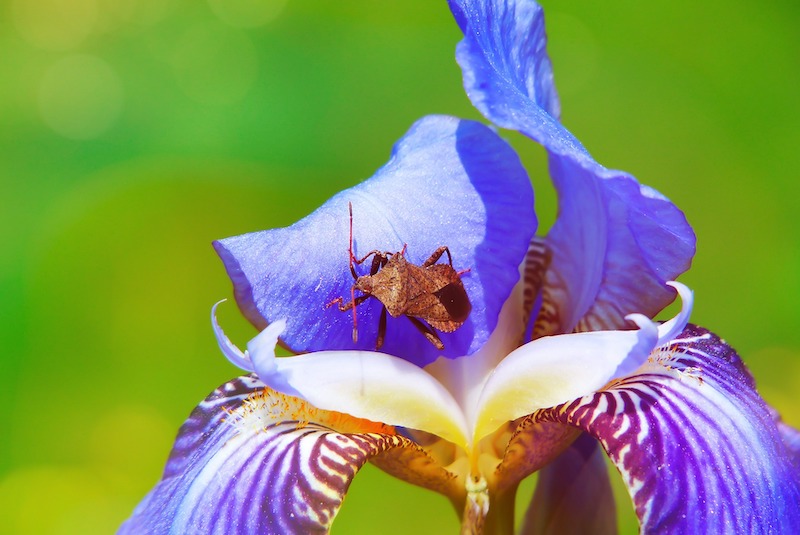
Common Iris Pests
Iris Borer
By far the most common pest for irises is iris borer. Adult Macronoctua onusta lay eggs on any part of the iris, and these can overwinter in even the coldest gardening zone. The pinkish-white larvae hatch in early May and burrow at the base of the foliage and tunnel into the rhizome and root system. Infestation can cause secondary bacterial and fungal infections, leading to the eventual rotting of the plant. Plants will begin to struggle to keep their leaves green or grow altogether. The larvae will pupate into cutworms, which burrow into the soil. The adults emerge in late August to lay eggs for the following season.
Treating Iris Borer
Iris borer can be controlled with chemical sprays made from pyrethrins or spinosad, but the application needs to begin at the first sign of tunneling on the foliage. Once the larvae have tunneled into the rhizome or the soil, sprays will not work. Drenching the soil with beneficial nematodes (specifically Heterorhabditis or Steinernema) can reduce populations of iris borer. Application of the nematodes is done in June and early July. Often the best control is to divide the iris rhizomes regularly and cut out any damaged areas before replanting.
Preventing Iris Borer
Good garden hygiene is the best defense against iris borers. Clear away any leaves that fall during the growing season and cut the plants back hard to eliminate areas for the eggs to overwinter. In locations where the borer has been a pest, early applications of an insecticide with pyrethrins or spinosad may be needed to keep the borer's to a minimal level.
Iris Mites
Rhizoglyphus echinopus is more commonly known as the iris mite. This small pest resides in colonies near the roots of the bulbs and rhizomes of iris and is a known vector for bacterial and fungal diseases. The mites invade plant tissue that has been damaged by mechanical means, such as by a garden fork or spade. The mites resemble very tiny eggs (0.03 of an inch long) and avoid light as much as possible. The only way to see what is causing the damage to your plant is to dig it up. Common symptoms include slowed or stopped growth, failing flowers, and drooping of top growth, which can look like dehydration.
Treating Iris Mites
Unfortunately, there are no chemical means of controlling iris mites. The main method of control is to burn or throw the plants in the trash. Do not use infected iris material in a home compost pile. The chance of the mites surviving the composting process is very high, since home compost piles rarely reach a sustained temperature of 150 degrees Fahrenheit to kill off pathogens.
Preventing Iris Mites
Always buy iris bulbs and rhizomes from certified sources. Look for varieties that are listed as being mite resistant, or only buy types that show natural resistance to iris mites. Siberian iris and Japanese iris are less likely to be affected than bearded irises.
Gastropods (Slugs and Snails)
Slugs and snails have a way of making themselves known in the garden. They are attracted to fleshy-leaved plants like iris, especially during the spring when fresh young growth is emerging. Ragged bites from the edges of the foliage are a dead giveaway that gastropods have been dining during the night. During the daytime, slugs and snails make use of any shaded and sheltered spot in the garden. A flower bed with heavy weed cover, upturned pots, or even thickly mulched areas are great hiding spots that stay cool and dark during the day. Often mature iris will recover from light feeding from gastropods. Newly seeded or transplanted irises may need protection until they can establish themselves fully in the garden.
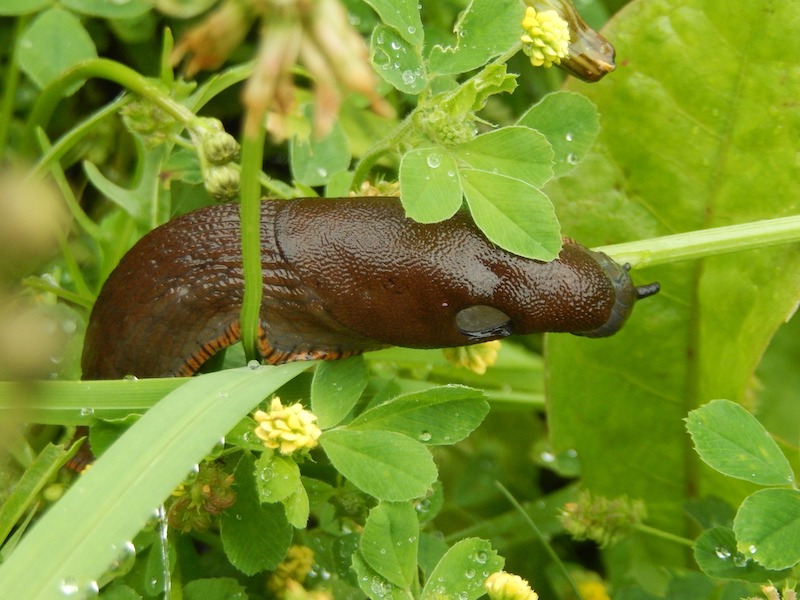
Treating Gastropods on Irises
There are many tried and true methods to treat for slugs and snails in the garden. Most often the simplest is the most effective. Shallow traps made from tuna cans and some sort of liquid (cheap beer works the best!) will attract and drown slugs and snails during the night. The gardener only needs to empty the traps and reset them in the morning.
If drowning the slugs and snails seems like too much work, wildlife-friendly slug bait is available for purchase. Sluggo is one brand that is perfectly safe to use around pets, children, and other wildlife in the garden. The main ingredient is iron phosphate, which breaks down in the soil as a light fertilizer if not consumed by the gastropods. Slug baits need to be reapplied after periods of heavy rain.
Preventing Gastropods on Irises
Preventing slugs and snails in the garden is an ongoing crusade. In some gardening zones, they are part of the local native population and will never fully be eradicated. On a greater scale, slugs in particular are efficient decomposers and a necessary part of the soil web ring. Ensure that any weedy parts of your garden stay clean and open to the sun. Keep gardening supplies such as pots and hoses neatly stacked or put away in a dry area when not in use. Use iron phosphate slug baits only around plants that need protection. Do not spread it in large areas in hopes of killing all gastropods in your yard.
Aphids
Aphids are common pests for most landscape plants. The sap-sucking pests often attack fresh new growth on plants that are compromised in some way. The aphids mainly attracted to irises are the green peach aphids, Myzus persicae, and are known vectors of mosaic viruses in iris. The green peach aphid sucks sap from the leaves and flower buds, causing distortion and uneven growth of the plant. If left uncontrolled, aphids will begin to excrete a sticky substance that is known as honeydew. This sap builds up on the surface of the plant and eventually drips to the ground or surrounding surfaces. Ants are attracted to the honeydew and can cover a plant while attempting to mine the honeydew to take back to their nest.
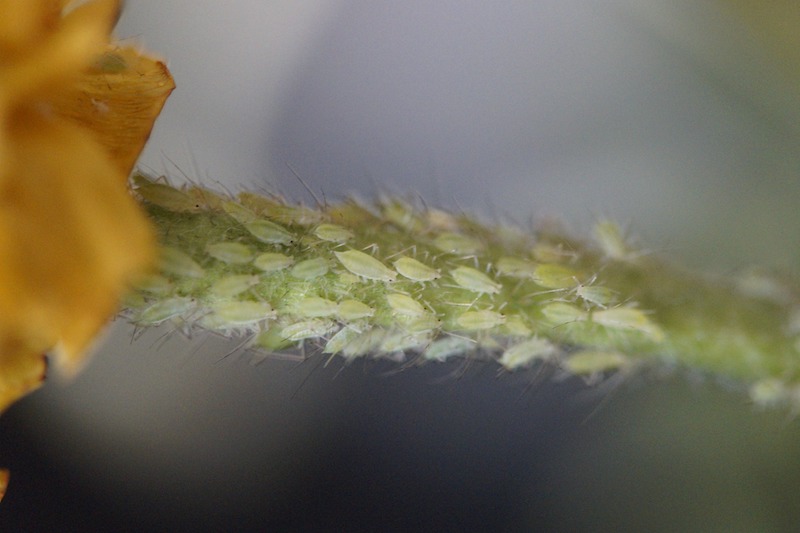
Treating Aphids on Irises
Treating aphids early after diagnosis is key to eradicating them from your irises. A strong blast from the garden hose will knock aphids off the plant while also drowning them. Repeat this treatment every 2-3 days until the infestation is over. Make sure to hit all surfaces of the leaves and stems. Aphids often inhabit the undersides of leaves or even roll up the leaf for protection. The next strongest treatment to try is an insecticidal soap spray, labeled for use on irises. Always follow the manufacturer's instructions. This treatment may need to be reapplied once every 2 weeks, especially after rain. Irises that are heavily infested with aphids may need to be dug out of the garden and disposed of in the trash. Aphids will spread not only to other irises but also to nearby plants.
Preventing Aphids on Irises
Weed control around and in the garden is the best way to prevent aphids from invading your irises. Bindweed, pigweed, and lambs quarters are common host plants for green peach aphids in particular. Encourage natural predators such as lady beetles, lacewings, and syrphid flies to inhabit your garden. Planting pollinator-attractant plants and not using toxic pesticides are good first steps to encouraging a healthy garden biome. Remember that predatory insects need food to survive. If the aphids are completely eliminated, the beneficial insects may leave as well in search of another food source. A balanced ecosystem helps keep both the predators and prey in check. Proper air circulation between plants keeps them healthy and discourages aphids from attacking. Keep supplemental fertilizing to a minimum. Overuse of nitrogen on plants encourages rapid foliage growth that is more susceptible to aphid attack.
Earwigs
Earwigs are one of the garden pests that gardeners can have mixed feelings about. These voracious chewing insects will strip flower petals to stubs in the course of one night, but they also eat their weight in other bad actors such as aphids, mites, fleas, and the eggs of many other pest insects. The rather large, reddish-brown earwig likes to hide during the day in any spot that is cool, moist, and dark. At night, they emerge ready to feed on mainly the flowers and flower stems of iris. Telltale damage are holes in the middle of petals, as well as ragged edges, or whole flower buds visibly eaten away.
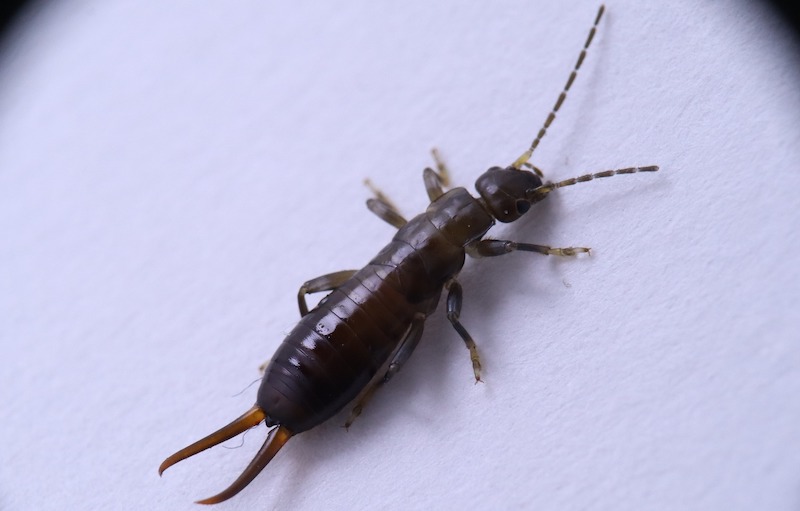
Treating Earwigs on Irises
Earwigs can be difficult to get rid of completely just with traps and other mechanical means. Because these beetles also serve as beneficial predators, it will be more advantageous to reach a level of balance between the earwigs and your plants. Insecticidal soap sprays will reduce populations. They need to be sprayed directly on the pest to be effective and may need reapplying. Sluggo has an organic slug bait that contains Spinosad to aid in controlling insects. Spinosad is a naturally occurring soil bacteria that is toxic to some insects. Always look for the OMRI stamp on garden products. That stamp ensures that the product has been tested to meet the latest organic growing standards.
Preventing Earwigs on Irises
Trapping and disposing of earwigs is an easy way to prevent excessive damage to the iris flowers. Earwigs like to crawl inside tight and dark spots for rest during the day. Trapping this pest is as easy as laying a wide piece of wood on the ground next to an infected plant in the evening and uncovering the earwigs underneath the next morning. The earwigs should be dumped in a bucket of soapy water to ensure that they will not return. Rolled-up sheets of newspaper or corrugated cardboard also make good earwig traps.
Japanese Beetles
Japanese Beetles are without a doubt the most hated garden pest east of the Mississippi River. These metallic green and copper beetles are gorgeous to look at, but they don’t mess around during their short life cycle. For 10 months of the year, Japanese Beetles live as white grubs with brown heads amongst the roots of large grassy areas in the garden. They feed on the roots of the grass and cause major damage and death to the turf. In mid-June, the grubs change to adults and start their rampage on plants above ground. For 40 days, adults feed on a wide variety of ornamental plants and food crops, including the flowers and foliage of irises. Leaves are skeletonized and flowers are devoured. Every two weeks during this period, the adults also lay grub eggs in grassy lawn areas. Finally, by the end of July, the adults die off and the grubs start hatching to feed on roots for the next 10 months.
Fortunately, most mature trees and shrubs are not permanently damaged during the eating frenzy and have some time left in the growing season to recover. Young plants, annuals, and some not-so-hardy perennials may be too weakened to recover and die before the summer is over.
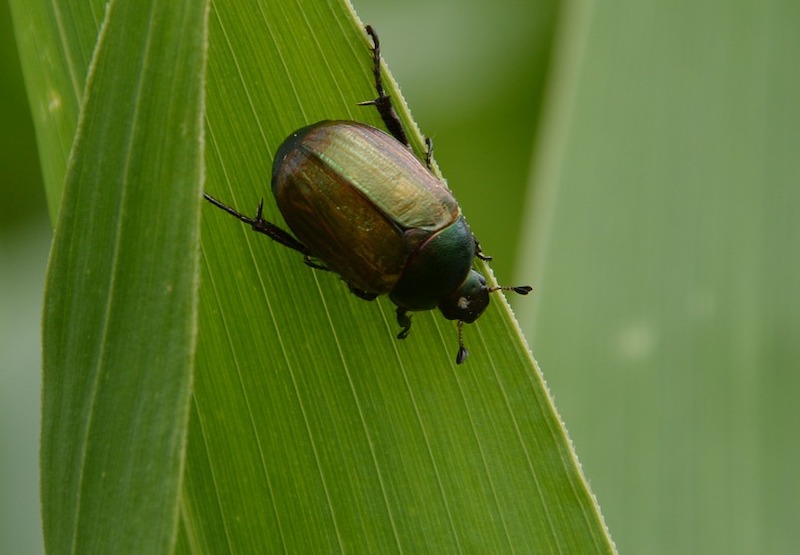
Treating Japanese Beetles on Irises
One form of protection against Japanese Beetles is to exclude them from the plants altogether. Using fine mesh or lightweight horticultural fabric to cover smaller plants, food crops, and prized plants during the active adult period. Many gardeners have gotten in the habit of placing pheromone traps around the garden to trap and kill Japanese Beetles. The idea is a good one, but the practice literally attracts more beetles to your garden. Unless the traps are placed as far away from the plants you want to protect, the pheromone traps may become expensive lures. Neem oil is often used to protect plants and make them less desirable to the Japanese Beetles. This only works for a short period of time and should be reapplied if plants are watered or rained on.
Preventing Japanese Beetles on Irises
The only way to reduce and possibly eradicate Japanese Beetles from your yard is to destroy the grubs. Treating the lawn with a drenching of milky spore bacteria will target and kill the grubs before they have a chance to turn into flying adults. There is no danger of upsetting the native inhabitants of the soil when using milky spore. This bacteria only targets Japanese Beetle grubs.
Iris Pests Chart
|
Pest |
Identifying |
Treating |
|
Iris Borer |
Pinkish-white larvae with brown heads |
Divide the iris rhizomes regularly and cut out any damaged areas before replanting |
|
Iris Mites |
Microscopic arachnids; slowed or stopped growth, falling flowers, and drooping of top growth, which can look like dehydration |
Burn or throw the plants, do not use infected iris material in a home compost pile |
|
Gastropods (Slugs and Snails) |
Ragged bites from the edges of the foliage |
Make shallow traps made from tuna cans and some sort of liquid to drown them during the night |
|
Aphids |
Small, soft-bodied insects that can be green, yellow, brown, red, or black, pear-shaped bodies with long antennae |
Strong blast from the garden hose will knock aphids off the plant while also drowning them |
|
Earwigs |
Medium-sized insects, brown or black, with elongated bodies, pair of prominent pincers, or forceps, at the end of their abdomen |
Use insecticidal soap sprays to reduce populations |
|
Japanese Beetles |
Shiny, metallic green body and copper-brown wing covers |
Use fine mesh or lightweight horticultural fabric to cover |
Sources:
"Iris (Iris)." The Connecticut Agricultural Experiment Station. portal.ct.gov
"Iris Borer." University of Maryland Extension. extension.umd.edu
 |
Author Robbin Small - Published 4-19-2023 |
